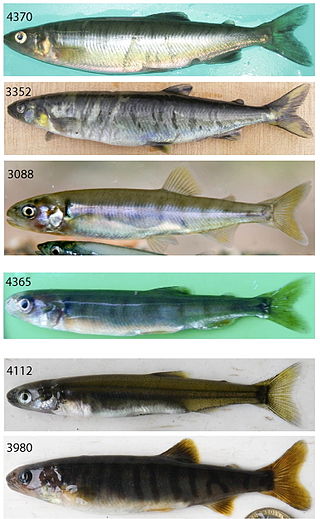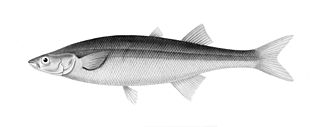
Characidae, the characids or characins, is a family of freshwater subtropical and tropical fish belonging to the order Characiformes. The name "characins" is a historical one, but scientists today tend to prefer "characids" to reflect their status as a, by and large, monophyletic group. To arrive there, this family has undergone much systematic and taxonomic change. Among those fishes remaining in the Characidae currently are the tetras, comprising the very similar genera Hemigrammus and Hyphessobrycon, as well as a few related forms, such as the cave and neon tetras. Fish of this family are important as food in several regions, and also constitute a large percentage of captive freshwater aquarium fish species.

Carl Henry Eigenmann was a German-American ichthyologist of the late nineteenth and early twentieth centuries, who, along with his wife Rosa Smith Eigenmann, and his zoology students is credited with identifying and describing for the first time 195 genera containing nearly 600 species of fishes of North America and South America. Especially notable among his published papers are his studies of the freshwater fishes of South America, the evolution and systematics of South American fishes, and for his analysis of degenerative evolution based on his studies of blind cave fishes found in parts of North America and in Cuba. His most notable works are The American Characidae (1917–1929) and A revision of the South American Nematognathi or cat-fishes (1890), in addition to numerous published papers such as "Cave Vertebrates of North America, a study of degenerative evolution" (1909) and "The fresh-water fishes of Patagonia and an examination of the Archiplata-Archelenis theory" (1909).

Rosa Smith Eigenmann was an American ichthyologist, as well as a writer, editor, former curator at the California Academy of Sciences, and the first librarian of the San Diego Society of Natural History. She "is considered the first woman ichthyologist in the United States." Eigenmann was also the first woman to become president of Indiana University's chapter of Sigma Xi, an honorary science society. She authored twelve published papers of her own between 1880 and 1893, and collaborated with her husband, Carl H. Eigenmann, as "Eigenmann & Eigenmann" on twenty-five additional works between 1888 and 1893. Together, they are credited with describing about 150 species of fishes.

Aplochiton is a genus of ray-finned fish of the family Galaxiidae native to Argentina, Chile and the Falkland Islands.

Cyprinodon is a genus of pupfishes found in waters that range from fresh to hypersaline. The genus is primarily found in Mexico, the Caribbean Islands and southern United States, but C. variegatus occurs as far north as Massachusetts and along the entire Gulf of Mexico coastline, and C. dearborni and C. variegatus are found in northern South America. Many species have tiny ranges and are highly threatened, in some cases already extinct. Cyprinodon are small; the largest reaches 10 cm (3.9 in) in length and most other species only reach about half that size.

Percilia is a genus of perch-like ray-finned fish in the monogeneric family Perciliidae.

Basilichthys is a genus of Neotropical silversides native to freshwater habitats in Chile and Peru. Many species now placed in Odontesthes were formerly included in Basilichthys instead.

Cheirodon is a genus of characins occurring in South America. Of the 10 currently described species; one, C. jaguaribensis, is placed here as a convenience, as its actual position in Characidae is unknown.
Cheirodon galusdae is a species of fish in the family Characidae endemic to Chile.

Cheirodon kiliani is a species of fish in the family Characidae endemic to Chile.

Cheirodon pisciculus, the pocha común, is a species of fish in the family Characidae endemic to Chile in freshwater environments within a benthopelagic depth range. This species is native to a subtropical climate. C. pisciculus is distributed in the Pacific versant of the Maipo, Aconcagua, the Huasco River basins, and the Estero Quintero in Chile. This fish can reach length of 5.5 cm (2.2 in) as an unsexed male.

The naked characin is a small species of fish in the family Characidae. It is the southernmost member of the family and the only member of the genus Gymnocharacinus. It is endemic to a stream near Valcheta in northern Patagonia, Argentina. Adults have no scales. It is endangered because of habitat loss.

The southern little pipehorse is a species of fish in the family Syngnathidae. It is endemic to Australia. Its natural habitats are open seas, shallow seas, subtidal aquatic beds, and coral reefs. It camouflages amongst species of red algae. It is threatened by habitat loss.

Moenkhausia is a genus of freshwater fish in the family Characidae native to tropical and subtropical South America. These are medium-sized tetras where the largest species only reach around 12 cm (4.7 in).

The gold tetra, or Rodway's tetra is a species of small freshwater fish in the family Characidae native to lowland South America, where they are abundant in coastal floodplains. Their name comes from a powdery golden tint on their body that is thought to be caused by internal parasites. Gold tetras are peaceful, hardy, schooling community fish. Gold tetras have been successfully bred in captivity.

Ectrepopterus uruguayensis is a small species of characin originally recorded only from streams in Uruguay, with occasional sightings in Brazil and Argentina. It is the only known member of the genus Ectrepopterus, which was formerly a subgenus of Megalamphodus. Given its restricted range, it is considered a rare fish, and is of note for conservation researchers interested in preserving the biodiversity of the region.

Aphyosemion australe, the lyretail panchax, golden panchax or Cape Lopez lyretail, is a species of freshwater fish belonging to the family Aplocheilidae. It is found around Cape Lopez and in surrounding areas in Gabon.

Carlastyanax aurocaudatus is a small species of freshwater fish in the family Characidae native to the Río Cauca in Colombia. It is the only member of the monotypic genus Carlastyanax, which was named in 1972 specifically for the species by Jacques Géry. Upon description, it was named Astyanax aurocaudatus by Carl H. Eigenmann. There has been debate concerning whether or not the genus should be recognized, but C. aurocaudatus is currently considered a valid species.
Zaniolepis frenata, also known as the shortspine combfish, is a species of ray-finned fish belonging to the family Zaniolepididae.The species occurs in the eastern Pacific Ocean.

Iguanodectidae is a family of freshwater fish in the order Characiformes that lives in South America. It is home to the subfamily Iguanodectinae and the monotypic Bryconops clade. Several species in the family, such as the green line lizard tetra, the tailspot tetra, and the orangefin tetra, are sometimes taken as aquarium fish.


















